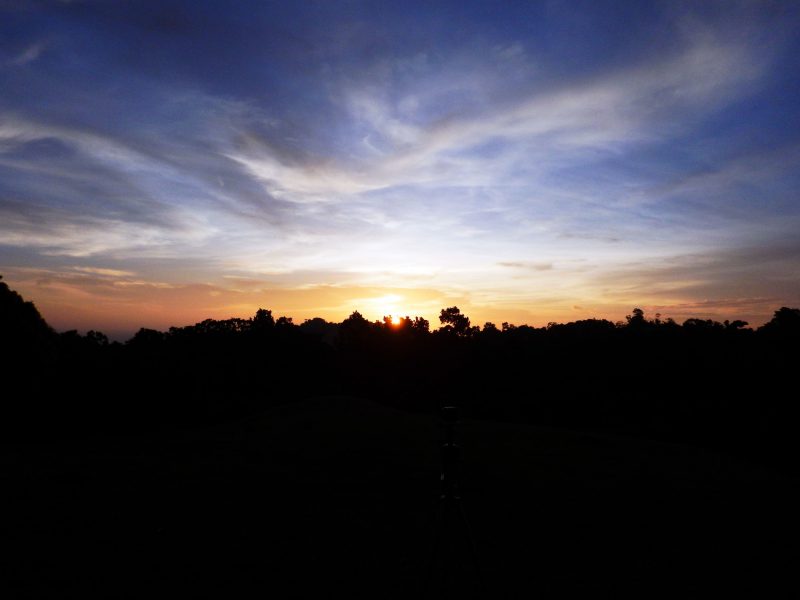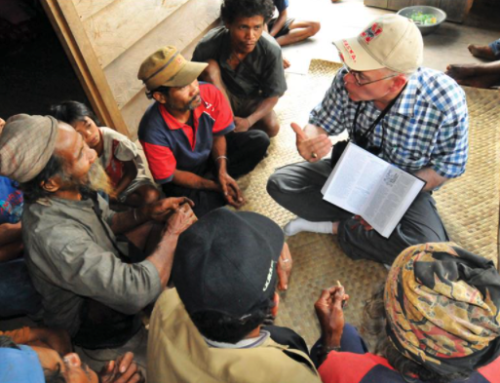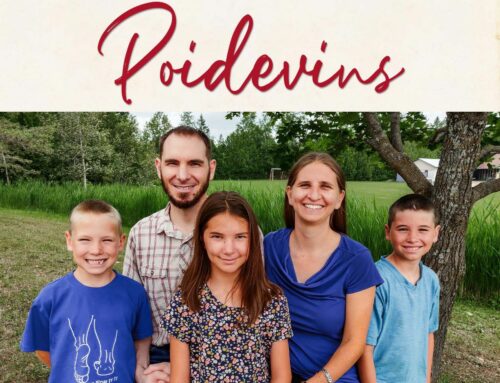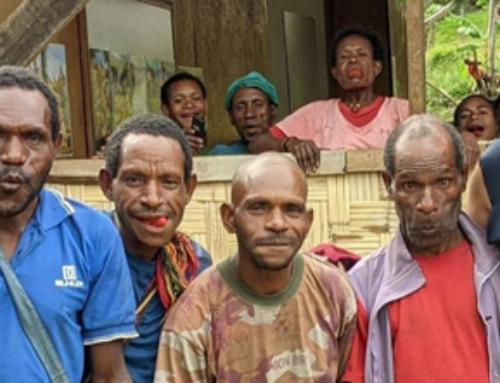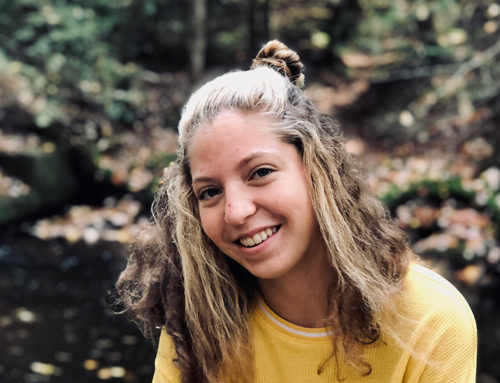Underneath the palm frond canopy of the church roof sat elders and deacons representing 24 churches and three teams of missionaries. The 50 men filled the church, its half-height walls permitting the early morning light to illuminate their faces. Each face told a story. And though we only heard a portion of them, each story contained a common element: Praise to God for His faithfulness as He built His Church in and through the Mouk people.
The Mouk live on the isolated island of New Britain in Papua New Guinea. Their name, “Mouk,” means “a live ember on the end of a stick waved back and forth to provide light on the paths at night.”
And indeed, God has sent His light to the Mouk, embodying in them the meaning of their name as they faithfully carried His light to every Mouk village and are now carrying it cross-culturally to the neighbouring Lusi, Anem and Kove peoples.
THE LIGHT COMES TO THE MOUK
In the mid-1980s a team of three missionary families moved into the Mouk village of Gigina: Mark and Gloria Zook, Kim and Vivian Walden, and a year later, Dave and Diann Yunker. They all dove into culture and language study.

After months of work, Mark reached fluency in the Mouk language and began teaching evangelistically using the chronological Creation to Christ lessons.
Concurrent with the Bible teaching, Gloria prepared materials for the first literacy class. Until the missionaries’ arrival, the Mouk people were illiterate, their language only spoken. Part of the missionaries’ culture and language study included reducing the Mouk language into a written form. Then Gloria had the privilege of teaching the Mouk to read their own language.
Mendo, one of the first Mouk Bible teachers, recounts the initial evangelistic Bible teaching: “We heard teaching [twice a day, five days a week] from the first of September until the third of December 1986. When we first heard it, we Mouk realized that this was big talk.
“We became believers. And we praise God very much for His mercy and His grace that came to us, the Mouk people, here in the middle of the jungle — a grace and mercy that our ancestors did not have and did not know about.”
INITIAL GOAL: THE MOUK REACH THE MOUK
After the evangelistic Bible teaching in the first village, Mark began discipling believing men to teach their own people.
Mendo said, “On the first of May 1987, [Mark, assisted by the Mouk teachers,] started to bring the Word of God to the second Mouk village, the village of Botagoigoi. We believed that it was important to take God’s Word to other Mouk villages.”
He adds, “Mark reached his goal at that point.”
What goal was Mendo talking about? The goal was to place the teaching into the hands of the Mouk believers. From that time forward, Mark never again preached the initial Creation to Christ lessons to the Mouk people. Instead, the Mouk believers took on the responsibility of evangelizing the other Mouk villages.
“In our insides [the Mouk seat of emotion] we were concerned and twisted about another nearby village by the name of Bogididing that had not yet heard the gospel,” Mendo said, expressing the Mouk believers’ burden for their own people.
Mendo and the other Bible teachers had been taught by example. The light of the gospel had come to their village first. After becoming believers, they helped Mark carry the light to the second village. Then they themselves carried the light to other villages.
The teaching and training leapfrogged from village to village. More and more Mouk heard God’s Word, believed its message and were taught to read it for themselves. In turn, more Mouk believers were trained to teach the Bible lessons or literacy classes. Between the Bible lessons, translated Scriptures and literacy materials, the missionaries were printing over 8,000 sheets of paper per month.
The Mouk had become the missionaries to their own people.
And the gospel spread like wildfire.
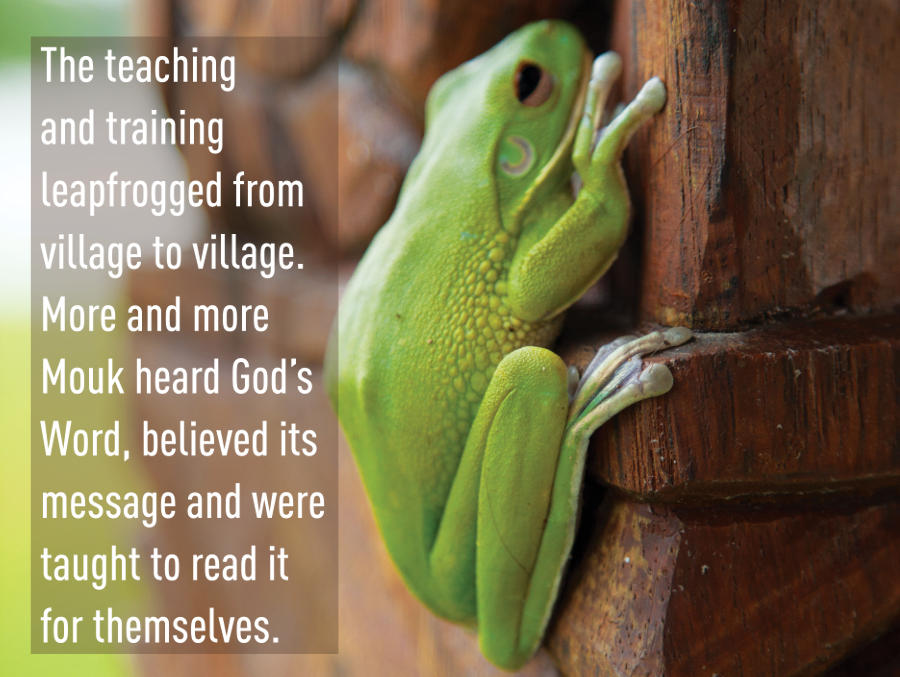
DISCIPLESHIP: MORE LIGHT FOR THE MOUK
Exponential growth was taking place as the believers evangelized the Mouk in distant villages. Building on the foundation of the initial evangelistic lessons, the missionaries’ main focus then shifted to provide the Mouk with even more light.
Dave Yunker, by now fluent in the Mouk language, immediately took on more responsibilities. He alternated with Mark putting the Creation to Christ Bible lessons into Mouk and teaching the believers while Mark continued to translate the New Testament.
They taught the new material in the original village each weekend. The Bible teachers, in turn, taught the lessons in distant villages. On their return, Mark and Dave reviewed the lessons with the men. In addition, the Bible lessons were put into booklet form and distributed to community libraries set up by the missionaries in each village.
Often Mark would send recordings on cassette tapes to the other villages. In fact, he had to create a large chart to track where each village was in the teaching and what each teacher himself still needed to be taught chronologically through the New Testament.
Literacy was a key “to growth in the Mouk church,” Gloria recalls. “They could sit and read and feed themselves spiritually. Without literates, Mark and Dave couldn’t have taught these men to teach and later be church elders. The women read to their kids, and men conducted family devotions.” Literacy was so important to the work that each time evangelistic teaching started in a new village, the missionaries sent in a literacy teacher and trainee along with the two Bible teachers and their families.
RELATIONSHIPS: THE CATALYST TO MINISTRY
Though Bible teaching didn’t start until the missionaries reached proficiency in the language, ministry to the Mouk began on day one. Diann mentions, “The first step really is when you get in there with the people, building relationships and showing that you care … because it’s not just their spirit and their soul, but it’s also their body and emotions.”
One way the missionaries demonstrated the love of Christ was through a medical ministry to the 1,500 Mouk in Gigina and the surrounding villages.
Initially, infant mortality was high. Malaria, pneumonia, tuberculosis and tropical ulcers along with machete and axe wounds were common. As a result, over 60 percent of all children never reached marriageable age. But the basic medicines and medical care offered by the three families greatly improved the lives of the Mouk.
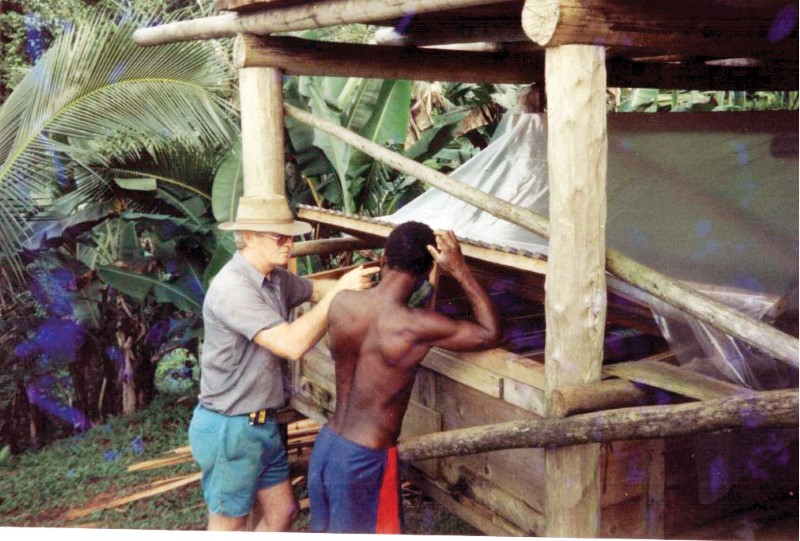
From the time of their arrival, Dave and Diann jumped into the medical work, and that eventually became Diann’s niche.
She recalls an older man named Lapaide who had severe breathing issues. “He would have died had we not given him medical treatment. I remember he wanted to live to hear the teaching. And he did.” God used Lapaide greatly as a believer to help with the older generation. “He would sit down and talk with them and go over the Bible lessons.”
Gordon and Heather O’Toole joined the team in 1990, shouldering many behind-the-scenes responsibilities. They assisted the Mouk through community development, taught the people to sew on hand-crank machines and headed the medical program. Additionally, they dealt with mechanical issues and repaired buildings for the team. Along with ministering to the Mouk in these unsung roles, the O’Tooles’ work expedited the church planting efforts by allowing the Zooks more time to focus on translation, Bible teaching and discipleship.
EXPANDING THE EDGES OF THE CHURCH: THE MOUK TAKE THE LIGHT BEYOND THEIR BORDERS
Patrick, a Mouk church deacon and literacy teacher, recalls how God burdened his heart for the neighbouring Lusi people. “In 1997 our missionary left us; he had to go home. We Mouk were all believers. But I thought, ‘Those around us who are not believers in other language groups, how are they going to hear the Good News that we have heard?’”
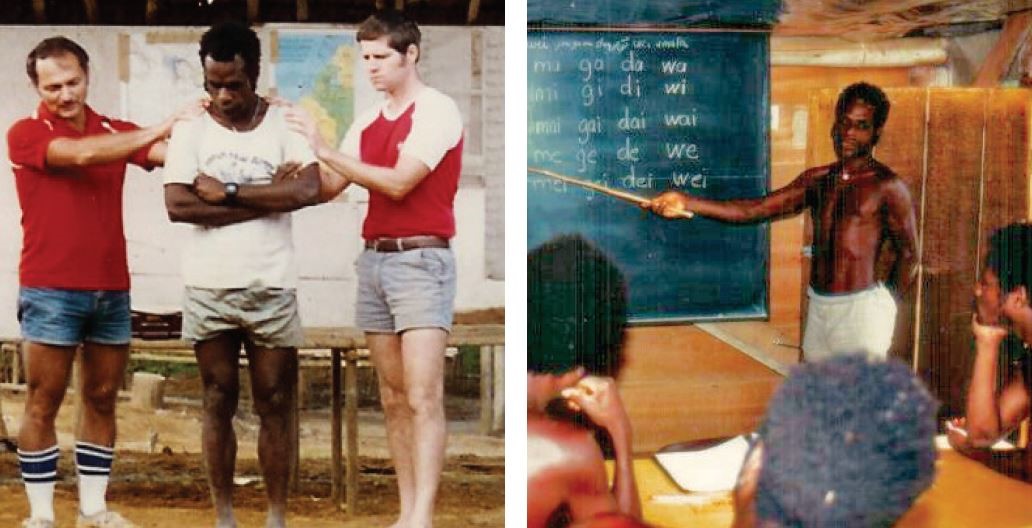
The Mouk began by reaching out to the Lusi in the trade language of Papua New Guinea. Jaret was one of those reached.
As a young man, Jaret attended high school on the other end of the island of New Britain, far from home. After school he returned to his village and married, but bad choices led to troubles. In fact, the troubles became so great that he couldn’t manage them in his home village on the coast. So he left.
That choice brought Jaret and his family, in 1999, to the inland village of Gigina where Mouk church elders invited him to hear the gospel teaching. He heard and believed, and Mouk teachers discipled him.
Jaret praises God for working in his life. “Because of the Mouk outreach and teaching and their further discipleship, I am in God’s hands and remain so today. … I lift up His Name and thank Him for a new existence, for new life in Christ.”
As Patrick considered further outreach to the Lusi people, he realized that teaching in their heart language would be the most effective way to communicate the Word of God to them. Even though the Lusi language completely differed from his own, Patrick was determined to learn it.
And God provided a way. At that time there were some people living in Patrick’s village whose fathers were Mouk and whose mothers were Lusi. Patrick reasoned that he could learn the language from them, and for three years he did just that.

Patrick began translating the Bible lessons into the Lusi language. Mark, in the USA at that time, advised Patrick to go and live among the Lusi people if he wanted to do the work well. The Mouk church agreed. “So then in 2003 along with the elders and the Christians at Botagoigoi, we were all in harmony that my family and I would relocate to the [Lusi] village of Gilau.”
Immersing themselves in this cross-cultural ministry to the Lusi people, Patrick and the other Mouk men taught the Bible, wrote accompanying curriculum and translated Scriptures into Lusi. But Patrick’s feeling of “not enoughness” in the area of translating Bible lessons weighed heavily on him. He shared his concern during one of the monthly meetings with the Mouk elders.
“All of the elders, we were all in agreement, we were all in harmony, that we needed to request a Western missionary to join along with me to help on the translation side of things,” Patrick declared. And so they did.
Missionary Jan Wols, who currently liaises with churches that the mission has planted, recalls that on one trip to the Mouk, the leaders explained to him, “We can do evangelism. We can do church planting. We can disciple. But Bible translation, that’s a huge job. We wouldn’t be able to do it. Would you possibly be able to provide us with a Bible translator?”
Jan brought the request back to the mission.
PURPOSEFUL PARTNERSHIPS: MISSIONARIES AND CHURCHES CARRY THE LIGHT TOGETHER
God had already prepared an answer to Patrick’s request. Years before, a young couple, Rick and Anji Zook, had trained in Bible translation with Ethnos. Both are uniquely gifted for this particular work.
Anji explains, “I think that when God gifts people, He doesn’t waste anything. He uses our gifts and our abilities. Before I came into the mission, I was a seventh grade language arts teacher. And before that I had majored in English in college. God took all those years of teaching, writing and revising, [and] now I’m using it with translation.” Rick quickly clarified that Anji serves as the primary translator, while he takes on the role of the secondary translator.
As Mark and Gloria Zook’s son, Rick had a notable advantage over most new missionaries studying culture and language. He spent his entire high school years living with the Mouk and, in his own words, he “had a relationship going way back with the Mouk people and Mouk church. … I grew up among them. I hung out with them. I knew their culture and language.”
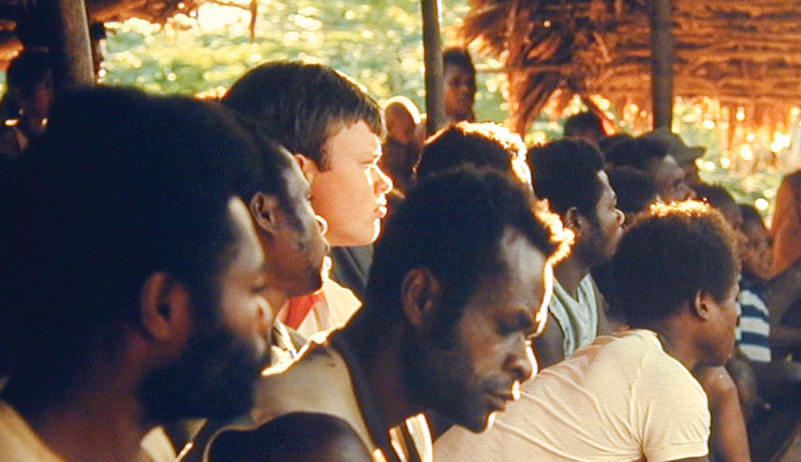
For Rick it was more than just knowing their language. He recognized the change in the lives of his friends once they trusted Christ.
“It was a profound and significant change, not a small thing,” Rick remembers. “They no longer lived in fear of sorcery. They no longer lived in fear of spirits. They had a freedom and a peace that they did not have before.”
During the time Rick and Anji studied with Ethnos and later when they arrived as missionaries in Papua New Guinea, God impressed upon them the wisdom of multiplication in missions, not just addition. They were convinced of the importance of purposeful partnerships — working hand-in-hand with, alongside and underneath the authority of the local church to see discipleship efforts multiplied.
That’s exactly the relationship that Rick and Anji have with their Mouk co-workers and the Mouk church. Rick describes their role as “assisting the Mouk to reach the Lusi.” Keenly aware that his role as a missionary is to equip others to minister, he asserts, “Our goal is not to hold on to all the jobs that we can. It’s to get rid of jobs as quickly as we can.” As such, their missionary team incorporates the concept of discipleship into all aspects of ministry, echoing how the Mouk were first reached.

Their Mouk teammates are capable men, but they had no training in learning a foreign language. Rick explains how they practiced the concept of discipleship in language learning. “Our co-workers sat with us, and we modelled for them language learning. They just sort of mimicked and went along with what we were doing. That’s how our initial three co-workers learned the Lusi culture and language.”
Rick and Anji developed language learning materials when three new families joined the team and later adapted those lessons for use in other languages.
Once a Mouk missionary completes language study, he is then mentored to become a language teacher to future missionaries. So far, 18 Mouk missionaries have completed the course.

MULTIPLICATION: THE MOUK TAKE THE LIGHT FURTHER
In addition to the cross-cultural missionary team sent to reach the Lusi people, the Mouk church sent out two teams to reach the Anem and Kove peoples. Those teams are discipling some believers using the trade language now, but they continue to study the Anem and Kove languages in order to communicate more clearly in each group’s heart language.

Last year Josiah and Rachel Van Der Decker accepted an invitation from the Mouk church to help reach the Anem people. Partnering with Mouk co-workers meant that Josiah and Rachel first needed to learn the Mouk language so they could communicate with their partners. Once the Van Der Deckers had completed their study of the Mouk culture and language, they joined their Mouk teammates in studying the Anem culture and language.
As the Van Der Deckers work together with the Mouk church in a purposeful partnership, the Mouk missionaries will focus on evangelism and discipleship, while Josiah and Rachel lead the translation effort.
And just like with Rick and Anji, the Mouk church reached out before asking Western missionaries to join the teams. In fact, the efforts to reach the Lusi, Anem and Kove peoples were all initiated by the Mouk church.

Josiah recalls the feeling of “not enoughness” that he and Rachel felt during their time of Mouk language study. But he is encouraged as they study Anem. “Thankfully God delights in using people like us to display His power through our weakness. Before us stands a seemingly insurmountable task, humanly speaking, but beside us and inside us dwells an amazingly powerful God. … He will build His Church among the Anem people, and we are just grateful He lets us be in on what He’s doing!”
THE LIGHT CONTINUES TO GO FORTH
Right now Mouk missionaries are teaching the Lusi believers through the book of Romans. Perhaps when they read chapter 10, they will see their own reflection in the story that God is writing for them. As Scripture says, “How shall they call on Him in whom they have not believed? And how shall they believe in Him of whom they have not heard? And how shall they hear without a preacher? And how shall they preach unless they are sent?” (NKJV)
The ember of the gospel among the Mouk has been fanned into flame. It began with a single village and moved on to another until it spread across the entire Mouk people group. That flame now blazes forth through the Mouk to the Lusi, Anem and Kove peoples.

